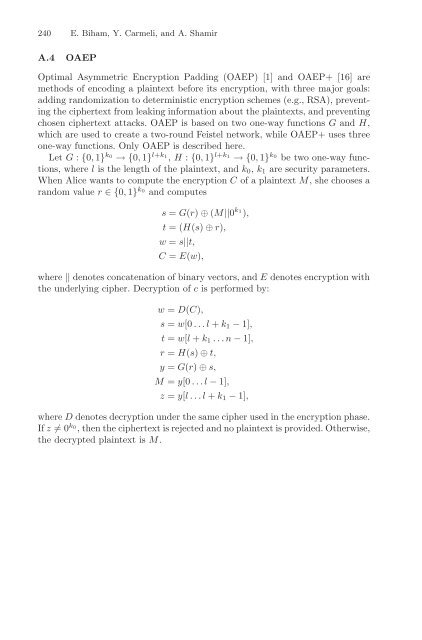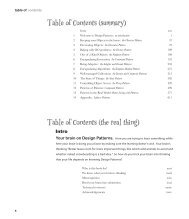rsa-bug-attacks
rsa-bug-attacks
rsa-bug-attacks
You also want an ePaper? Increase the reach of your titles
YUMPU automatically turns print PDFs into web optimized ePapers that Google loves.
240 E. Biham, Y. Carmeli, and A. Shamir<br />
A.4 OAEP<br />
Optimal Asymmetric Encryption Padding (OAEP) [1] and OAEP+ [16] are<br />
methods of encoding a plaintext before its encryption, with three major goals:<br />
adding randomization to deterministic encryption schemes (e.g., RSA), preventing<br />
the ciphertext from leaking information about the plaintexts, and preventing<br />
chosen ciphertext <strong>attacks</strong>. OAEP is based on two one-way functions G and H,<br />
which are used to create a two-round Feistel network, while OAEP+ uses three<br />
one-way functions. Only OAEP is described here.<br />
Let G : {0, 1} k0 →{0, 1} l+k1 , H : {0, 1} l+k1 →{0, 1} k0 be two one-way functions,<br />
where l is the length of the plaintext, and k 0 , k 1 are security parameters.<br />
When Alice wants to compute the encryption C of a plaintext M, shechoosesa<br />
random value r ∈{0, 1} k0 and computes<br />
s = G(r) ⊕ (M||0 k1 ),<br />
t =(H(s) ⊕ r),<br />
w = s||t,<br />
C = E(w),<br />
where || denotes concatenation of binary vectors, and E denotes encryption with<br />
the underlying cipher. Decryption of c is performed by:<br />
w = D(C),<br />
s = w[0 ...l+ k 1 − 1],<br />
t = w[l + k 1 ...n− 1],<br />
r = H(s) ⊕ t,<br />
y = G(r) ⊕ s,<br />
M = y[0 ...l− 1],<br />
z = y[l...l+ k 1 − 1],<br />
where D denotes decryption under the same cipher used in the encryption phase.<br />
If z ≠0 k0 , then the ciphertext is rejected and no plaintext is provided. Otherwise,<br />
the decrypted plaintext is M.



